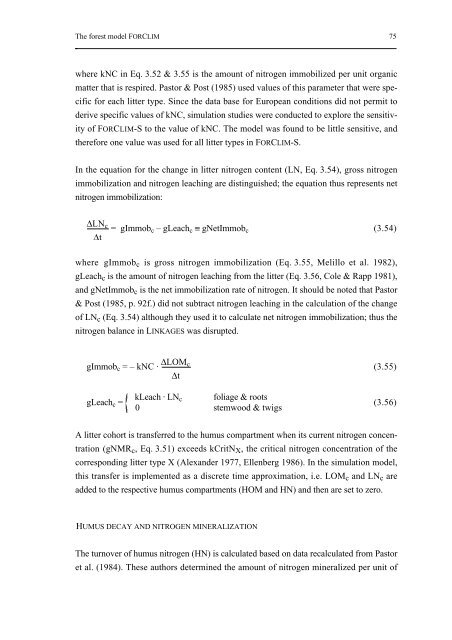On the Ecology of Mountainous Forests in a Changing Climate: A ...
On the Ecology of Mountainous Forests in a Changing Climate: A ...
On the Ecology of Mountainous Forests in a Changing Climate: A ...
You also want an ePaper? Increase the reach of your titles
YUMPU automatically turns print PDFs into web optimized ePapers that Google loves.
The forest model FORCLIM 75<br />
where kNC <strong>in</strong> Eq. 3.52 & 3.55 is <strong>the</strong> amount <strong>of</strong> nitrogen immobilized per unit organic<br />
matter that is respired. Pastor & Post (1985) used values <strong>of</strong> this parameter that were specific<br />
for each litter type. S<strong>in</strong>ce <strong>the</strong> data base for European conditions did not permit to<br />
derive specific values <strong>of</strong> kNC, simulation studies were conducted to explore <strong>the</strong> sensitivity<br />
<strong>of</strong> FORCLIM-S to <strong>the</strong> value <strong>of</strong> kNC. The model was found to be little sensitive, and<br />
<strong>the</strong>refore one value was used for all litter types <strong>in</strong> FORCLIM-S.<br />
In <strong>the</strong> equation for <strong>the</strong> change <strong>in</strong> litter nitrogen content (LN, Eq. 3.54), gross nitrogen<br />
immobilization and nitrogen leach<strong>in</strong>g are dist<strong>in</strong>guished; <strong>the</strong> equation thus represents net<br />
nitrogen immobilization:<br />
∆LN c<br />
∆t<br />
= gImmob c – gLeach c ≡ gNetImmob c (3.54)<br />
where gImmob c is gross nitrogen immobilization (Eq. 3.55, Melillo et al. 1982),<br />
gLeach c is <strong>the</strong> amount <strong>of</strong> nitrogen leach<strong>in</strong>g from <strong>the</strong> litter (Eq. 3.56, Cole & Rapp 1981),<br />
and gNetImmob c is <strong>the</strong> net immobilization rate <strong>of</strong> nitrogen. It should be noted that Pastor<br />
& Post (1985, p. 92f.) did not subtract nitrogen leach<strong>in</strong>g <strong>in</strong> <strong>the</strong> calculation <strong>of</strong> <strong>the</strong> change<br />
<strong>of</strong> LN c (Eq. 3.54) although <strong>the</strong>y used it to calculate net nitrogen immobilization; thus <strong>the</strong><br />
nitrogen balance <strong>in</strong> LINKAGES was disrupted.<br />
gImmob c = – kNC · ∆LOM c<br />
∆t<br />
(3.55)<br />
gLeach c =<br />
kLeach · LN c foliage & roots<br />
0 stemwood & twigs<br />
(3.56)<br />
A litter cohort is transferred to <strong>the</strong> humus compartment when its current nitrogen concentration<br />
(gNMR c , Eq. 3.51) exceeds kCritN X , <strong>the</strong> critical nitrogen concentration <strong>of</strong> <strong>the</strong><br />
correspond<strong>in</strong>g litter type X (Alexander 1977, Ellenberg 1986). In <strong>the</strong> simulation model,<br />
this transfer is implemented as a discrete time approximation, i.e. LOM c and LN c are<br />
added to <strong>the</strong> respective humus compartments (HOM and HN) and <strong>the</strong>n are set to zero.<br />
HUMUS DECAY AND NITROGEN MINERALIZATION<br />
The turnover <strong>of</strong> humus nitrogen (HN) is calculated based on data recalculated from Pastor<br />
et al. (1984). These authors determ<strong>in</strong>ed <strong>the</strong> amount <strong>of</strong> nitrogen m<strong>in</strong>eralized per unit <strong>of</strong>















